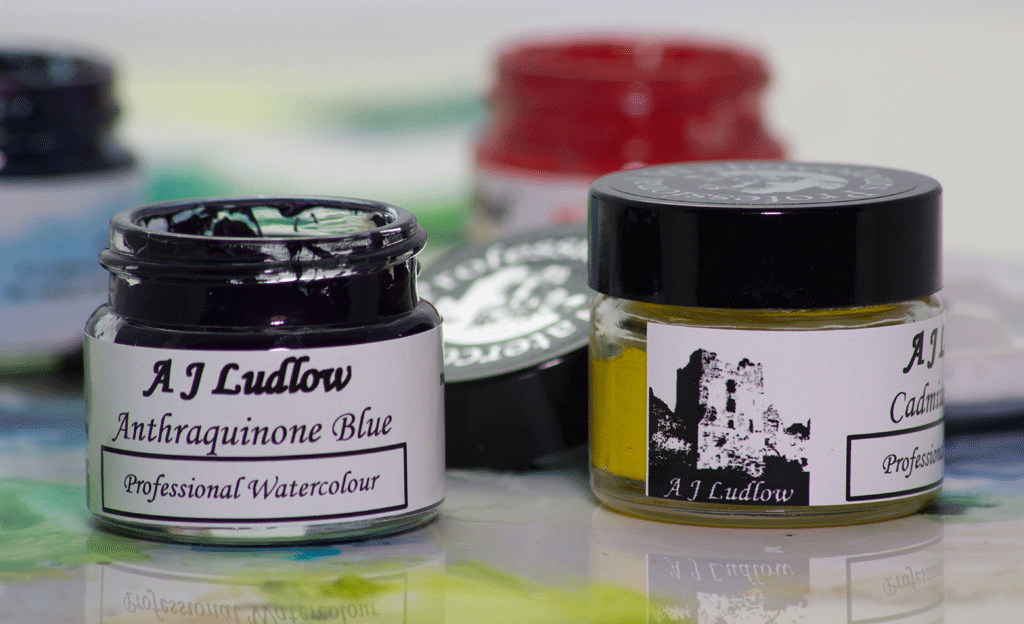ARTicles
Painting with A J Ludlow Watercolours.
Watercolourist Lesley Linley, puts A J Ludlow Professional Watercolours through their paces.

Hello; we’ve not met here before so here’s an introduction.
I’ve always been involved in art; my first career was Graphic Design, my second was teaching in Adult Education (calligraphy, painting, drawing) along with some freelance painting and calligraphy work.
In 2004 I moved to the Isle of Skye and eventually opened a studio and began full time self-employment. The studio was perfect for producing and exhibiting my paintings and running watercolour workshops for local people and holidaymakers from all over the world. In 2017 I began work on my book Mountains in Watercolour (Search Press), which features the area around my home on Skye, as part of their popular series ‘Ready to Paint in 30 minutes’. I moved back to Derbyshire in 2018; the road has been a bumpy one since then, with family health, injury and the pandemic disrupting plans.
In 2019 I met Andrew and Meiru (A J Ludlow) at Patchings Festival; I’d not heard of the company before – not surprising as it was so new - and took the opportunity whilst there to ‘have a dabble’ with their watercolours. I’d fallen out of love with my old brand when manufacture moved overseas; later changes further diluted my enthusiasm for the product and my confidence in it. I liked the A J Ludlow colours and was thrilled to find a British manufacturer but I had a lot of my old brand which I felt I couldn’t discard. A few weeks later I broke my back and briefly wondered if my painting days were over; fortunately the break was stable and I completed physiotherapy just before Covid entered UK life.
My book was published in March 2020 as lockdown began and my book promotion events and classes were cancelled. I couldn’t visit the waterfalls that I wished to paint and had to search for inspiration at home. I began a series of paintings featuring glassware, shadows and flowers, quite a change from landscape painting but I enjoyed it. I also wrote a few articles for Leisure Painter, another new venture.
In March 2021 I needed surgery to repair a cut tendon in my right (painting) hand; months of physiotherapy went into restoring function and, once more, I found myself wondering how the injury would affect my ability to paint. Over the summer I became a stranger to my craft. When I began painting again I started with small pieces; I found that I would need to make some adjustments to how I work, but I could paint. Fate intervened again a few weeks later as I became a full-time carer and painting was once more set aside.
2022 saw the return of Patchings Festival and I met Andrew and Meiru again, but I still had all that old paint and no time to use it! Bereavement a few weeks later meant that I suddenly had a lot of time on my hands. When I did get the paint out I found that much of it had hardened in the tubes; it can be extracted but it’s not the best use of my precious hands.
Painting with A J Ludlow Watercolours.
In December I was reminded about A J Ludlow Colours. Within minutes I was studying the list of colours available. I began to feel a buzz of excitement and anticipation for painting that had been missing for a long time. I chose colours that were close to those of my old brand where possible and a few new ones.
The arrival of my A J Ludlow Watercolours just before Christmas was a huge pick-me-up and an excuse to play with the paint. I made a colour mix chart so that I could get a feel for the paint and compare the new range with my old colours; my choices worked out quite well and I found some promising new combinations.
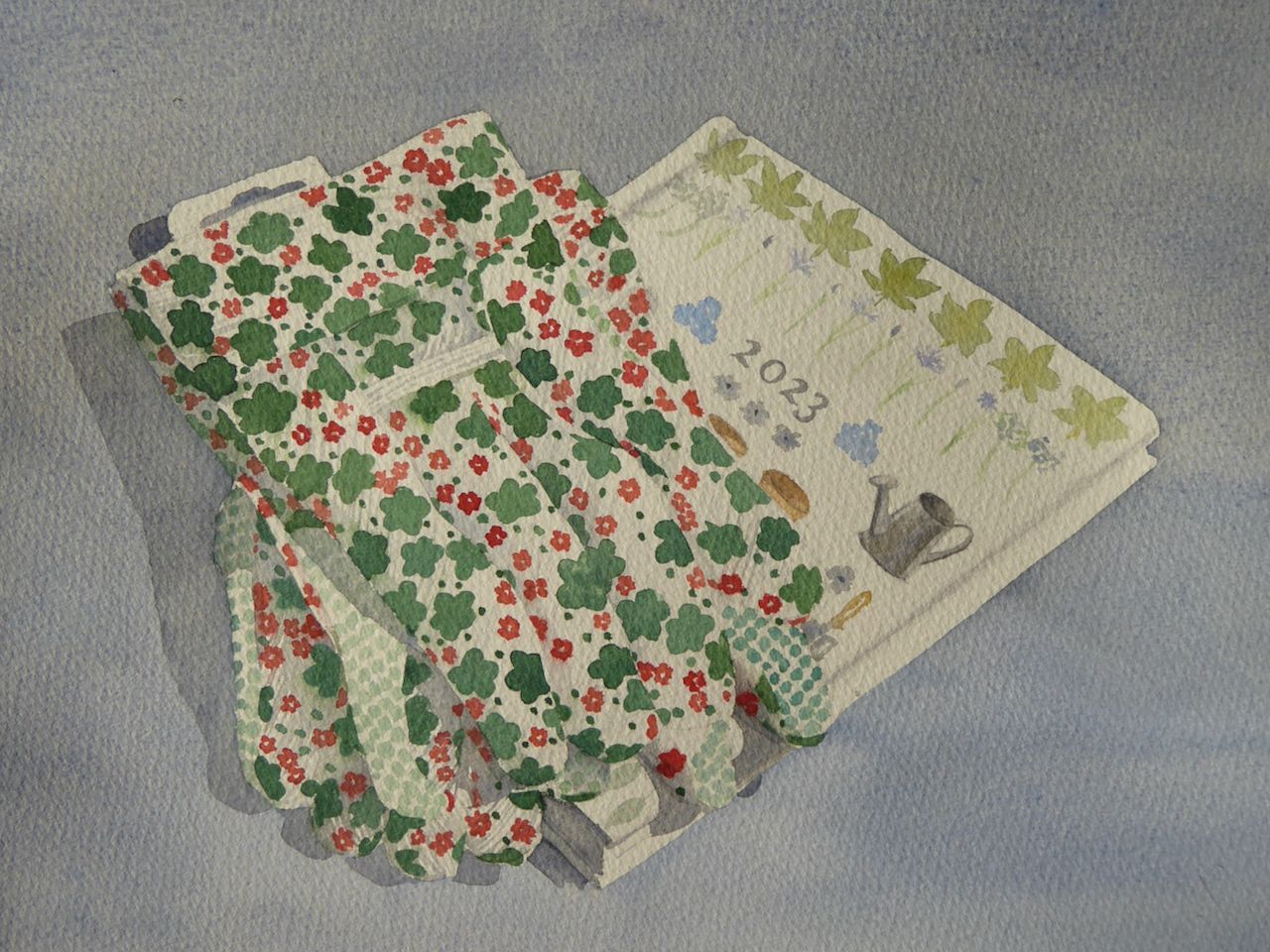
“Gardening Gifts” a watercolour painting by Lesley Linley - This was my first painting with the AJL colours.
I’d switched from pans to tube colours in my old brand soon after I began to paint professionally as it’s quick and easy to get a good volume of concentrated colour to the palette. I find that tube paint remains clean and fresh, whereas pans can (in some hands at least) become contaminated. How would I like these colours that come in jars? It was certainly a form of presentation I’d not encountered before.
I actually find the jars quite handy and it’s easy to keep the colour fresh and clean; I use a palette knife to take paint from the jar and wipe the knife immediately so that I don’t contaminate colours. The label is easy to read and the glass jar provides a window to the contents. There’s no ooze of binder from the colour as sometimes happens with tube paint. I replace lids immediately so that colours don’t dry out, just as I would replace a lid on a tube and I leave unused colour on my palette for future use, just as I would with tube colour. In practice, the change from tubes to jars has been no problem at all. So far so good, I like the packaging, but what do I think about the contents?
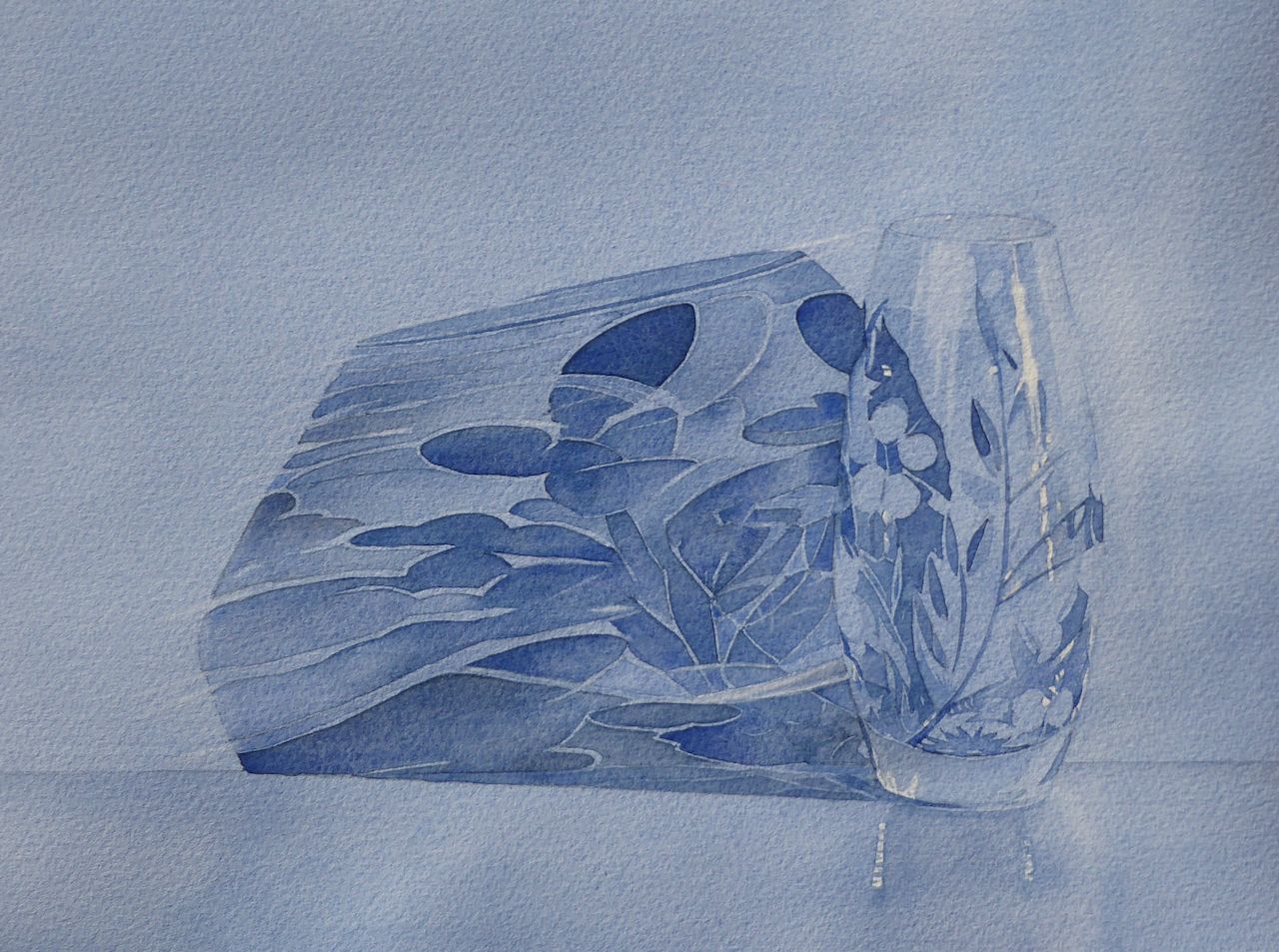
“Bud Vase” a watercolour painting by Lesley Linley - A painting using those two ‘must have’ colours (Burnt Umber and Ultramarine).
I love the tonal range of the Burnt Umber, which unlike my old brand, is single pigment and much darker. Burnt Umber is one of my two ‘can’t be without’ colours. I mix it with Ultramarine (the other colour that I couldn’t be without), varying the quantities of each for a wide range of warm, cold or neutral greys. I’ve found that I can easily mix the Umber with Burnt Sienna and/or Raw Sienna (or Transparent Iron Oxide Red and/or Transparent Iron Oxide Yellow) if I wish to get close to the colour of my old brand. (I doubt that I need to have the Transparent Iron Oxide colours as well as Raw and Burnt Sienna but I’m curious to compare them and ordered the Siennas after initially trying the Iron Oxides). I’ve used Raw Sienna a lot in the past, but I’m currently using Transparent Iron Oxide Yellow often; it has a strange look when taken from the jar but dilutes smoothly. The Burnt Sienna is less ‘orange’ than my old range but is a lovely warm brown. I have more experimentation to do with these Oxides and Siennas; the handling characteristics of a colour are as important to me as the colour itself.
I thought I would miss Quinacridone Gold which I used to use with Prussian Blue for a deep rich green but I’ve found that a tiny amount of Quinacridone Rose added to Azomethine Green gives me something close enough, for my needs, to Quinacridone Gold. I haven’t bought greens for many years but I have Azomethine Green in my palette of A J Ludlow Watercolours; I regard it as a yellow and find it particularly good when mixed with Prussian Blue or Phthalo Blue GS for rich greens (and with a tiny amount of Quinacridone Rose the green is neutralised a little). Most of my colours are transparent and stain to some degree. I’ve used Cadmiums very little in the past because of their opacity but I now have three, I’ve not used them much yet but have found them surprisingly pleasant to use.
I rarely paint people but was keen to check possibilities for skin tones and successfully mixed colours near to those of my own skin from various combinations of Transparent Iron Oxide Red, Transparent Iron Oxide Yellow, Ultramarine and Burnt Umber; substituting the oxides for the siennas seems to work well too.
I was very happy with my initial selection of colours for landscape painting. I have added Anthraquinone Crimson for flowers and still life, and Isoindolinone Yellow because I wanted to try an additional transparent yellow. Some colours are very strong and I’m still getting accustomed to just how little I need to use.
Don’t be put off by the long, perhaps unfamiliar names of some A J Ludlow Colours; I shorten the names in my own notes and those for students, there’s nothing scientific about it, just my own abbreviations for which I provide a key (for example, Azomethine Green becomes Azo). If you’re unsure which colours to choose you can ask for advice or choose a starter set; you might discover some lovely new mixes, as I have.
I have 16 AJL Colours in total, but rarely use more than 6 in a painting, often only two or three.
So, after trying a new brand after 30+ years, what do I think? I’m very pleased with the A J Ludlow Watercolours and I love the fact that I’m, once again, using a quality British made watercolour paint, following in the tradition of watercolourists for around two hundred years.
My A J Ludlow watercolours to date are:
- Cadmium Lemon
- Cadmium Yellow
- Transparent Iron Oxide Yellow
- Raw Sienna
- Isoindolinone Yellow
- Azomethine Green
- Cadmium Scarlet
- Quinacridone Rose
- Anthraquinone Crimson
- Transparent Iron Oxide Red
- Burnt Sienna
- Burnt Umber
Here are some of my paintings with these colours; a range of subjects and I’m happy with how the paint performs on all.

“Christmas Shadows” a watercolour painting by Lesley Linley - I set about this painting purely because I loved the shadows cast by the decorations. I found that I needed a little crimson for the shadows on the red fabrics, I didn’t have this in my AJL colours but I do now.

“Frozen II (Waterfall)” a watercolour painting by Lesley Linley - I’d painted a similar icy scene a few years ago and painted this purely to see how my new colours compared. There were no disappointments.
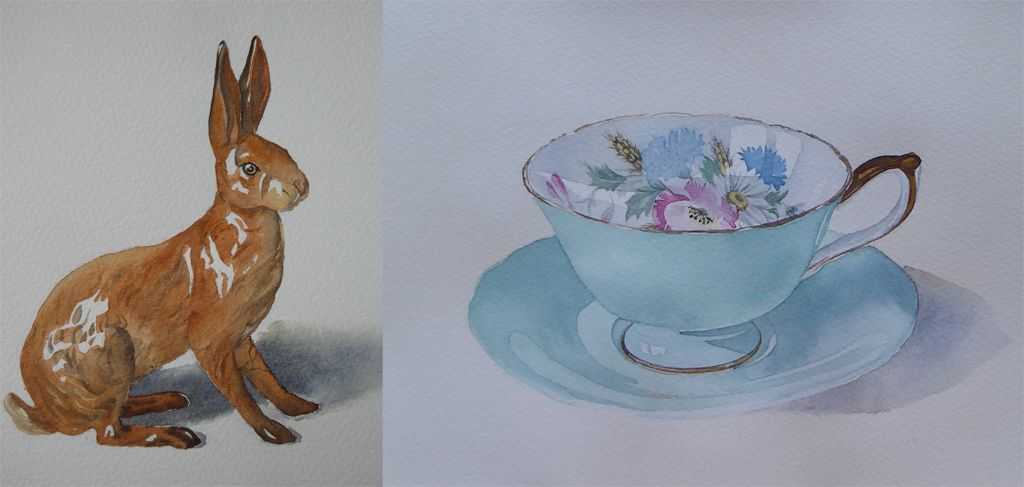
“Hare” a watercolour painting by Lesley Linley (LHS) and “Gran’s china” a watercolour painting by Lesley Linley (RHS)
These damaged pieces were heading for the bin but I decided they could be used in paintings before they met their fate. When painting ‘just for fun’, the results are often fresher than a subject which has been laboured over for too long.

“Lumsdale” a watercolour painting by Lesley Linley - I was becoming known for waterfall paintings before lockdown, this is taken from an old photograph.
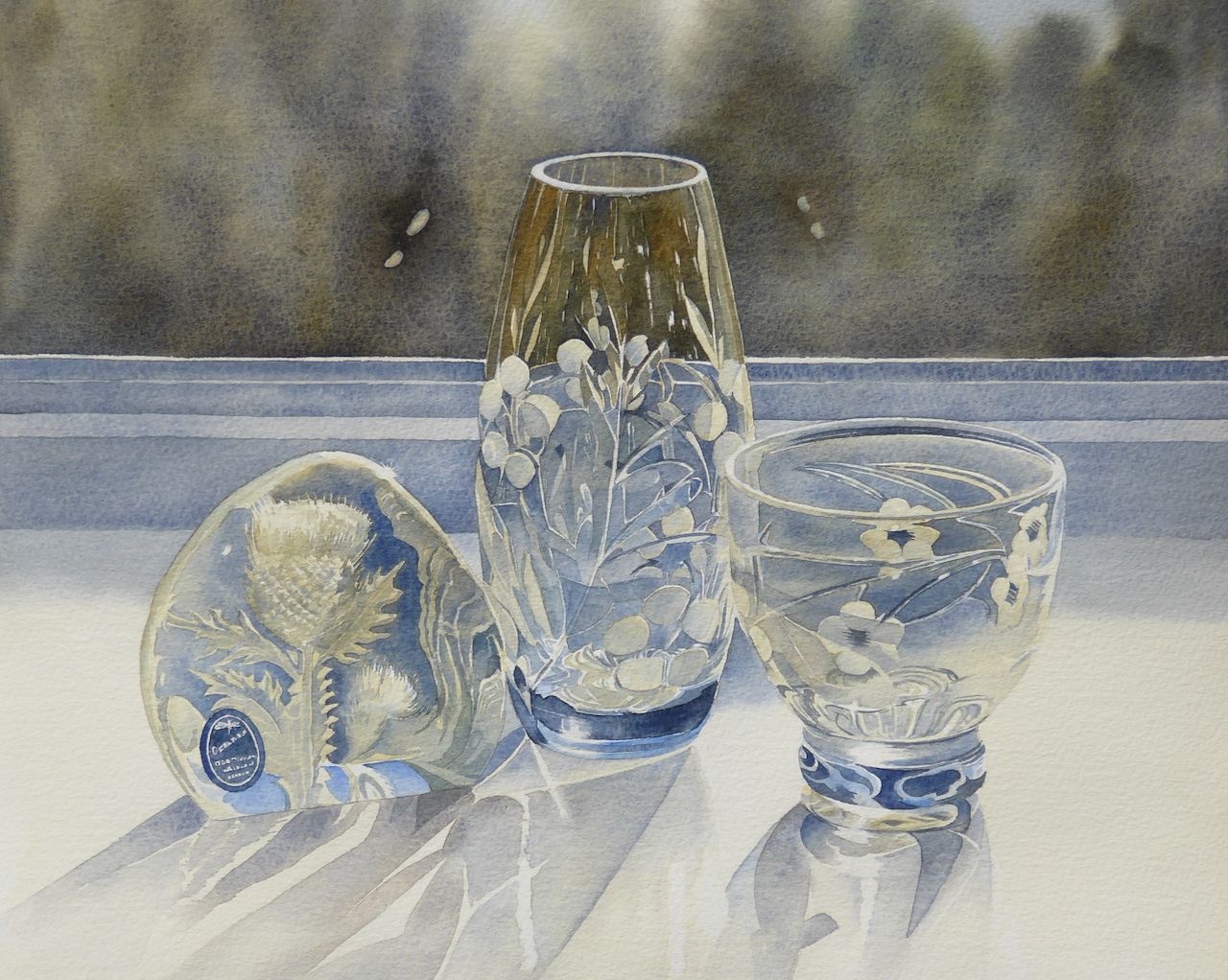
“Sunlight glass at the window” a watercolour painting by Lesley Linley - This was more effective several hours before I put my brush down; annoying but that’s life!




